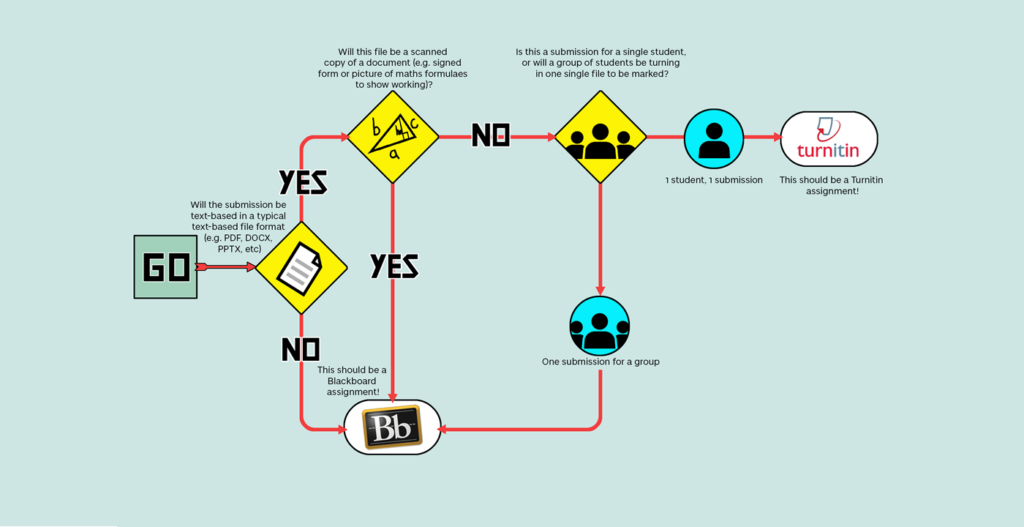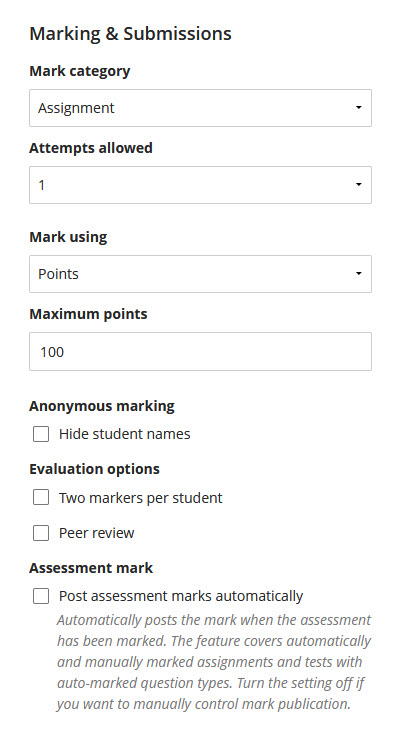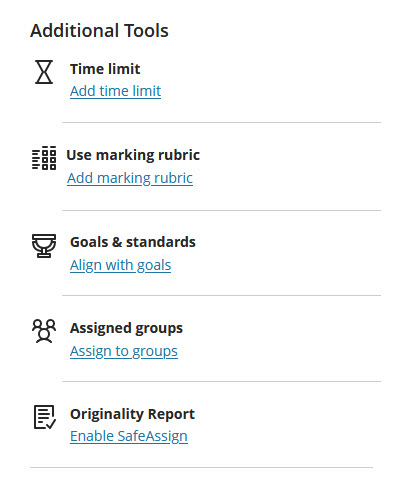What is it?
Use this guide to help you set up a Blackboard assignment, including determining if Blackboard assignments are the best tool for you.
Blackboard tests and assignments are functionally the same, so you will see settings here that will not apply to your assignment. This guide will let you know what these are.
What does it do?
If your assignment is a text-based item, it should likely be made with Turnitin. You can use the workflow below to determine if you should use a Blackboard or Turnitin assignment.
Is your submission text-based in a typical text-based file format (e.g. PDF, DOCX, PPTX, etc.?
If your answer to this is “No”, you should use a Blackboard assignment. If the answer is “Yes”, please move on to the next question.
Will this file be a scanned copy of a document (e.g. signed form or picture of a maths formula)?
If your answer to this is “Yes”, you should use a Blackboard assignment. If the answer is “No”, please move on to the next question.
Is this a submission for a single student, or is this a group submission where one single file will be marked for the group?
If this is for a single student, you should use a Turnitin submission point. If you are setting up a group assignment where one student will submit on behalf of the group, you should make a Blackboard assignment, and use our guide for group assignment creation.

What should I know?
Creating an assignment
Step 1: To create a Blackboard assignment, go into your module and hover over where you want the assignment to be and click on the + and select Create.
Step 2: Select Assignment from the list of options in the side panel.
Step 3: Add a title in the top left-hand side of the screen and adjust the availability to students in the top right-hand side (this will default to ‘Hidden from students’).
Step 4: Click on the + in the middle of the screen to add content. To add instructions, select the option Add text.

Assignment settings
Click on the cog wheel next to Assignment Settings or click on any of the links in the side menu, and a panel will appear for the full settings for tests and assignments.
Details & Information
In the Details & Information section, you will need to add in the due date and time. If the assignment is open for students for eg. practice assignment then you can choose option of no due date. You can also add in any settings you’d like to prohibit late submission or prevent students from starting the assignment after the due date has passed.
You can also allow a class conversation – this is a discussion board linked to this specific assignment.
Finally, you can use the option for offline submissions. This option lets you provide marks and feedback within your module page for assignments that are handed in as hard copy only. You should not use this option if you want students to submit anything digitally.

Presentation Options
You can skip this section as it is for tests rather than assignments.
Marking & Submissions
In the Marking & Submissions section, you can determine the category, the number of attempts, select the marking schema (for example, points or 23 to Alphanumeric) and set the number of points.
We recommend that you allow two submissions so that students have a back-up already in place if they have any technical difficulties when they try to submit. However, you can also add an extra attempt to a specific student, so if you keep this as one attempt, you still have the ability to allow more submissions on a case-by-case basis.
If you do allow multiple attempts, you’ll see a new drop-down menu appears that lets you choose which attempt to mark. For an assignment, you can see all of a student’s attempts so you can enter each attempt individually and decide which you want to use to mark, although this will typically be the last submitted item.
In addition to this, you can make the assignment anonymous, add a Peer Review function, and allow and assign multiple markers.
There are a few quirks with the anonymous marking setting that you should be aware of before you use it. The first is that there is not a way to de-anonymise any student or submission individually. The only way to release a student name is to post the marks and feedback for ALL students. This can pose a problem if there is an issue with a student submission that you spot and you want to contact the student to ask them to re-submit the assignment. There is also no way to re-hide the names once they have been released, and once marks have been posted any updates to marks will be posted to students automatically.
If you use the anonymous setting, then the previous advice we gave about allowing an individual student additional attempts is no longer correct. As you cannot see names in the submission box for anonymous assignments, you will not be able to grant specific students more attempts. There is a workaround for this that we’ll discuss in later in this video in the section on Assessment Security.
Finally, if you set up anonymous marking and use SafeAssign, you will not see originality reports until you have already posted marks.
The last item here, Post assessment marks automatically, is very important and we strongly recommend you leave this setting off. If you enable this, marks and feedback will be released automatically and immediately as you mark. If you don’t use this setting, you can post grades manually for the assignment in order to release marks to your students once all marking has finished.

Assessment Results
You can skip this section as it is for tests rather than assignments.
Assessment Security
The option in the assessment security is to add an access code. This will automatically generate a six-digit code that students will have to enter before they can access the assignment. This is useful if you have not set up any restrictions on submitting or starting late work, you have the anonymous setting enabled, and you want to provide a single student with an additional attempt. For this specific use case, you can change the attempts from “1” to “2”, turn on the access code, and only provide the code to the student who you would like to have the additional attempt.
As this code will lock the assignment, this is best used after the assignment due date has passed so you don’t restrict students who are trying to submit normally. And that is also why you will need to make sure that restrictions for late work are not applied. We realise this can be a bit confusing, so if you have any questions, please don’t hesitate to give us a shout through Help4U.
Additional Tools
In the additional tools section, you can add a time limit. This will start from the moment students click “start attempt”. In general, we would advise against this for an assignment as it is very possible this could prevent a student from uploading working. However, if you do use it in this context you can also decide if you want work to be automatically saved and submitted at the end of this timer or if you want to add additional time. The additional time added is currently very constrained – you have the options of allowing 50%, 100%, or unlimited extra time.
If you set this up accidentally, you can hover over the time limit link and a bin icon will appear. Clicking on that icon will remove the time limit.
You can use the next link to create and use a marking rubric. We won’t cover the details of this setting, but you can read Blackboard’s guidance on how to use rubrics.
Goals are set up as a university, and as we don’t have these set up, we will skip this option.
Below that is the option to turn this into a group assignment. For more information on this, check out our guide on setting up group assignments.
Finally, the last option is to set up a SafeAssign report. This is much like Turnitin’s similarity report, although it has less robust features than Turnitin – such as a not-very-effective integration with anonymous marking that we mentioned earlier.
To use SafeAssign, you will want to click the link for “Enable SafeAssign” and then tick this box to “on” in the next screen. Once you’ve enabled this you will have two further options – to allow students to view their reports and to exclude submission’s from Blackboard’s database.
We strongly recommend that you turn on the ability for students to view their reports as it can help students learn how to cite their work correctly. It is also standard that students will see their reports in Turnitin, so they will likely expect to have access to this as well. We recommend that you turn off the option is to exclude submissions from Blackboard’s database.

Once you’ve set up your assignment, be sure to click Save at the bottom of the settings panel.
Finally, we strongly recommend that once you have completed setting up your assignment that you use your Student Preview account to view the assignment and test any settings to make sure that the assignment is set up and functioning as you would expect. As you saw, there are many settings and adjustments to one setting can impact another setting.
